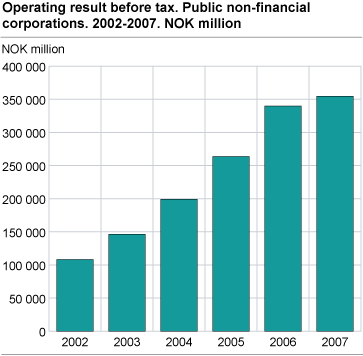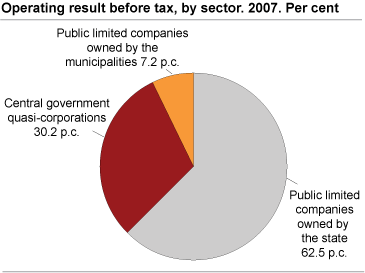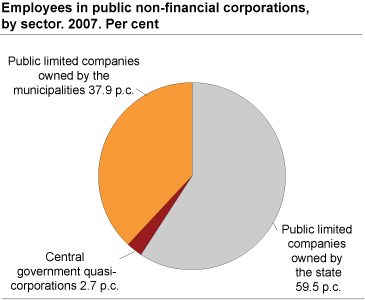Content
Published:
This is an archived release.
Profitable development
Public non-financial corporations achieved a profitable account in the 2007 accounting year. The high profit is mainly attributed to enterprises involved in oil, gas and mining and energy supply. Corporations involved in transport and communication also achieved high profits.
Public non-financial corporations achieved some NOK 354 billion in profit before tax in 2007. This is about 35.4 per cent of the operating income. The corresponding figures for 2006 were NOK 340 billion and 38.3 per cent respectively.
The high profit is mainly attributed to the exploration of crude oil and natural gas, which contributed about NOK 273 billion to the profit before tax, or 77 per cent. SDFI and Statoil ASA dominate this industry.
The electricity supply industry had a good year in 2007. The profit before tax was NOK 49.7 billion and the net profit for the year was NOK 40 billion.
The transport and communication industry achieved a profit before tax of NOK 20.8 billion and a net profit of NOK 17.3 billion. The major corporations in this industry include Telenor ASA, Posten Norge AS and Norges Statsbaner AS.
Central government corporations with highest profit
Central government corporations and central government quasi-corporations together accounted for some NOK 329 billion or 93 per cent of the total profit before tax. SDFI alone accounted for about NOK 113 billion1. The major business units included Statoil ASA, Statkraft SF and Telenor ASA.
For local government, energy supply enterprises were most profitable.
Moderate increase in asset value
Public non-financial corporations’ total assets value amounted to NOK 2 094 billion at the end of 2007. This was an increase of about NOK 387 billion from the previous year. The value of the fixed assets increased by 20.8 per cent, while the value of the current assets relating to sales of goods and services increased by 31.5 per cent.
However, most of the capital is located in a small number of companies. Approximately 50 corporations contributed about 75 per cent of the total assets. Each of these corporations has an asset value of more than NOK 6 billion. Twelve of these capital-intensive enterprises are owned by local government and located in the energy supply industry and two are in real estate.
The financial situation
The public non-financial corporations had a relatively stable financial structure in the period 2002 to 2007. Since 2003, the equity ratio has been around 41 per cent. Furthermore, the ratio of fixed assets to long-term capital has been relatively stable and was about 1. In other words, fixed assets have been financed by long-term capital. The debt-equity ratio has been relatively stable.
The current ratio has had a moderate downward development from 2003 and was about 0.81 in 2007. This means that the current assets are lower than the current liabilities. The figures do not necessarily illustrate the enterprises’ liquidity and therefore require careful consideration.
Central government quasi-corporations have been excluded here because the equity in these corporations cannot be compared with other public corporations. The central government quasi-corporations comprise the SDFI, Statens Kartverk, Statsbygg and Forsvarsbygg, together with the four districts’ hospital dispensaries. These corporations are wholly owned by the state.
Employment
Some 134 500 people were employed by public non-financial corporations at the end of 2007. There was an increase of around 5 500 new employees in 2007, which is a more significant increase than in previous years. This can be explained as the result of approximately 200 new enterprises.
Central government corporations had the largest number of employees and about 80 000 people were employed at the end of 2007.
Central government quasi-corporations employed some 3 600 at the end of 2007. One of the reasons for the increase in the number of employees in 2002 was the restructuring of Forsvarets Bygningstjeneste as Forsvarsbygg. This resulted in increased responsibilities. Luftfartsverket was restructured as Avinor AS and went from being a central government quasi-corporation to a central government corporation. This resulted in a significant reduction in the number of employees in central government corporations in 2003.
There has been a systematic increase in the number of employees in enterprises owned by local government during the period. About 51 000 people were employed by these enterprises at the end of 2007. Generally, no enterprise had more than 1 000 employees in this sector.
Public ownershipBoth the central and the local government have a significant ownership interest in Norwegian business and industry. The public companies vary with regard to economic activity and employment. The level of ownership varies from holdings in large listed corporations to small fully-owned enterprises. The corporations are involved in activities such as oil and gas exploration, energy supply, transport, real estate operations and rehabilitation. Oil and gas is the dominating business area and includes the State’s Direct Finance Investment (SDFI) and Statoil ASA among others. Corporations in the transport and communication industry are the largest employers. These industries include Posten Norge AS, Telenor ASA and Norges Statsbaner AS. DevelopmentThere were about 3 100 public non-financial corporations at the end of 2007. In addition, Statistics Norway has not obtained accounting data for about 100 enterprises. These are mainly small enterprises. Since 2002, the number of publicly owned enterprises have almost doubled. One reason for this development is that some major enterprises have been reorganised either as a result of takeovers or buying and selling of corporations. Another explanation is the improved method of data collection in Statistics Norway. The increase is quite significant during the period 2003 to 2005. As a result, the increase from year to year will not be completely correct. |
About the statisticsThe statistics include all market non-financial corporations in which either the central government or municipalities/county municipalities directly or indirectly own more than 50 per cent of the shares. These include all companies incorporated by special legislation as well as central government market entities. Types of corporationsCentral and local governments are mainly engaged in the following types of corporations: -Private limited companies and public limited companies, including public corporations. -Central and local government market entities, so-called quasi-corporations. -Companies incorporated by special legislation. IFRS (International Accounting Standards)As from the accounting year 2005, Norwegian companies registered at Oslo Stock Exchange must use international accounting standards. Other Norwegian corporations can choose to use international accounting standards. Nevertheless, Statistics Norway does not have well defined information about the population of public-owned non-financial corporations that have started using the IFRS. Subsequently, the transition to international accounting standards can affect the comparability of the accounting figures, for example the value of assets. |
Tables:
- Table 1 Public non-financial corporations. Income statement. Selected accounting figures. 2002-2007. NOK million and per cent
- Table 2 Public non-financial corporations. Balance sheet. Selected accounting figures. 2002-2007. NOK million and per cent
- Table 3 Public non-financial corporations. Income statement and balance sheet by section. Selected accounting figures. 2007*. NOK million
- Table 4 Public non-financial corporations, with out central government enterprises. Selected key figures. 2002-2007
- Table 5 Central government corporations. Income statement. Selected accounting figures. NOK million and per cent. 2002-2007
- Table 6 Central government corporations. Balance sheet. Selected accounting figures. NOK million and per cent. 2002-2007
- Table 7 Central government corporations. Selected key figures. 2002-2007
- Table 8 Central government quasi- corporations. Income statement. Selected accounting figures. 2002-2007. NOK million and per cent
- Table 9 Central government quasi- corporations. Income statement. Selected accounting figures.2002-2007. NOK million and per cent
- Table 10 Local government owned enterprises. Income statement. Selected accounting figures. 2002-2007. NOK million and per cent
- Table 11 Local government owned enterprises. Balance sheet. Selected accounting figures. 2002-2007. NOK million and per cent
- Table 12 Local government owned enterprises. Selected key figures. 2002-2007
Contact
-
Francis Kwamena Acquah
E-mail: francis.kwamena.acquah@ssb.no
tel.: (+47) 40 90 26 62



